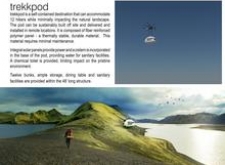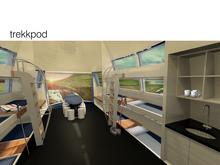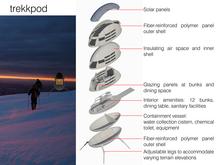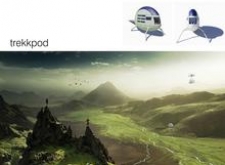5 key facts about this project
At the heart of the design is an innovative approach to sustainability. The TrekKpod utilizes a range of carefully selected materials, including fiber-reinforced polymer panels and integral solar panels, to enhance its energy efficiency and reduce its ecological footprint. The outer shell is constructed with fiber-reinforced polymer, which not only offers durability but also minimizes maintenance needs, making it well-suited for remote locations. The incorporation of solar panels into the design allows the pod to harness renewable energy, ensuring that occupants have access to power while relying minimally on external resources.
The spatial organization within the TrekKpod is designed to maximize comfort and efficiency. The interior features twelve bunks positioned in a manner that fosters a sense of community while ensuring practical usage of space. The layout includes a central dining area that encourages social interaction, further enhancing the experience of communal living. Essential sanitary facilities are integrated thoughtfully into the design, which ensures a comfortable stay without compromising privacy.
Another notable aspect of the TrekKpod is its adaptability to a variety of terrains. The adjustable steel legs provide necessary stability on uneven ground, which is a common challenge in outdoor settings. This feature allows the structure to be easily deployed in remote locations, making it accessible for a wide range of outdoor activities. The architectural design embraces an organic aesthetic that resonates with the surrounding natural landscape, evoking shapes reminiscent of seeds or eggs—symbols of shelter and protection.
The efficiency of the design extends beyond its physical elements. Water collection systems, including cisterns for water storage, enhance the pod's self-sustainability and convenience for occupants. With a compact footprint of approximately 48 feet, the design ensures that the TrekKpod minimizes land use while maximizing livability.
Throughout the architectural development of the TrekKpod, there is a clear emphasis on creating a balance between built structures and the natural environment. The thoughtful integration of renewable energy sources, efficient use of materials, and innovative spatial arrangements exemplify the potential for architecture to address the needs of modern outdoor living.
For anyone interested in modern architectural designs that prioritize sustainability and community, the TrekKpod offers an engaging case study. To explore this project further, including its architectural plans and sections, and to engage with its unique design ideas, we encourage readers to review the project presentation for additional insights and a deeper understanding of this compelling architectural endeavor.


























